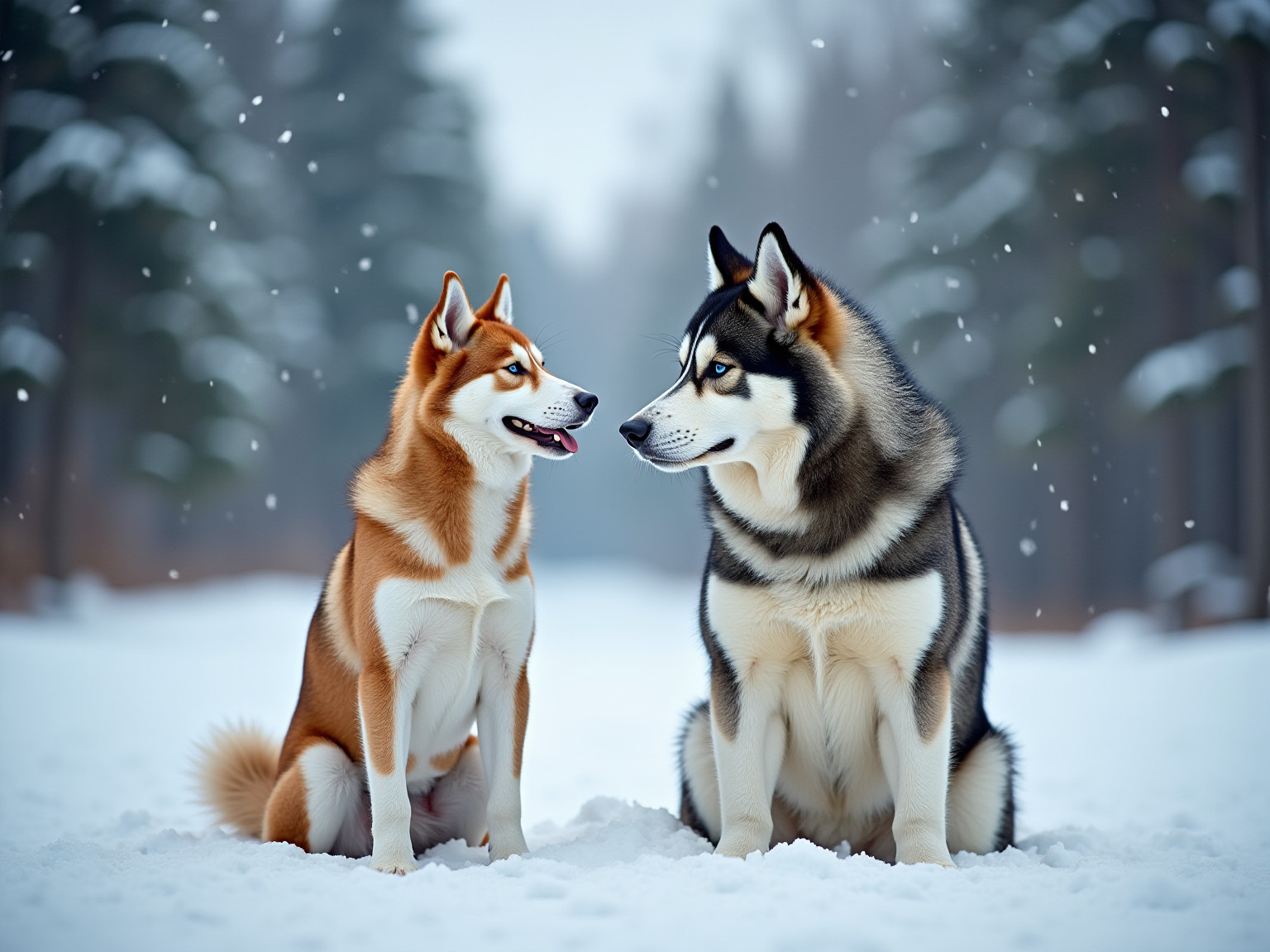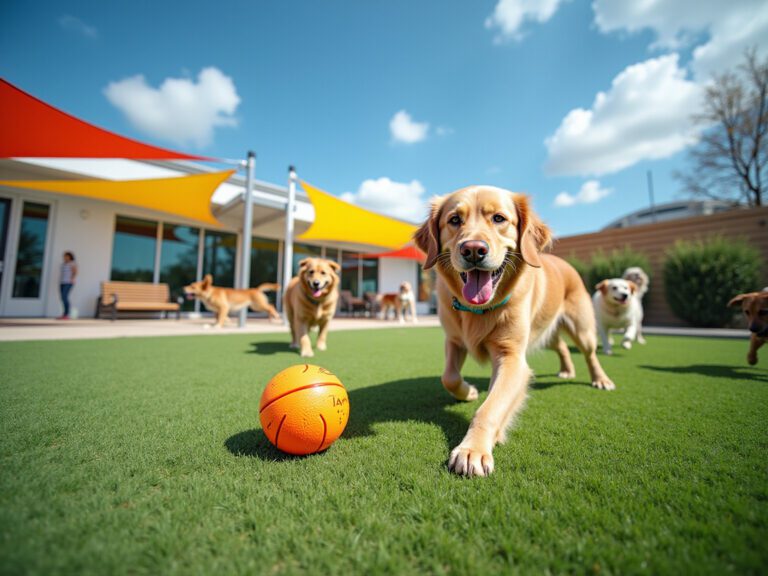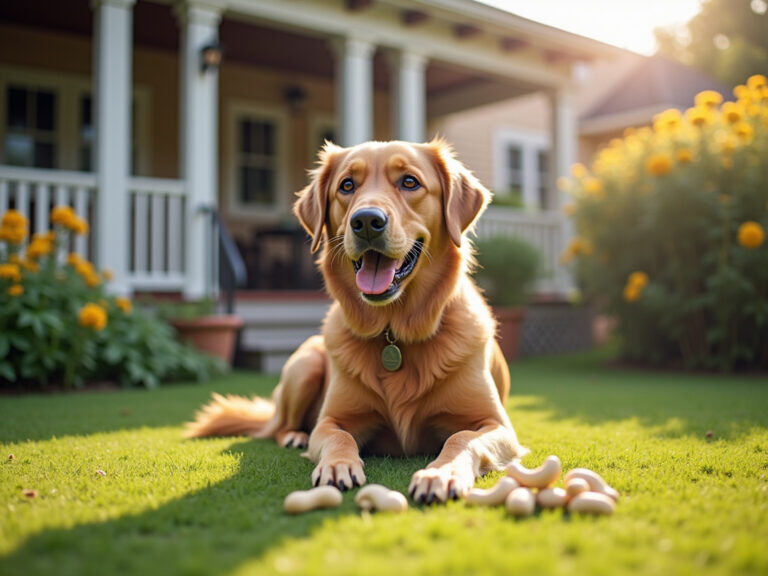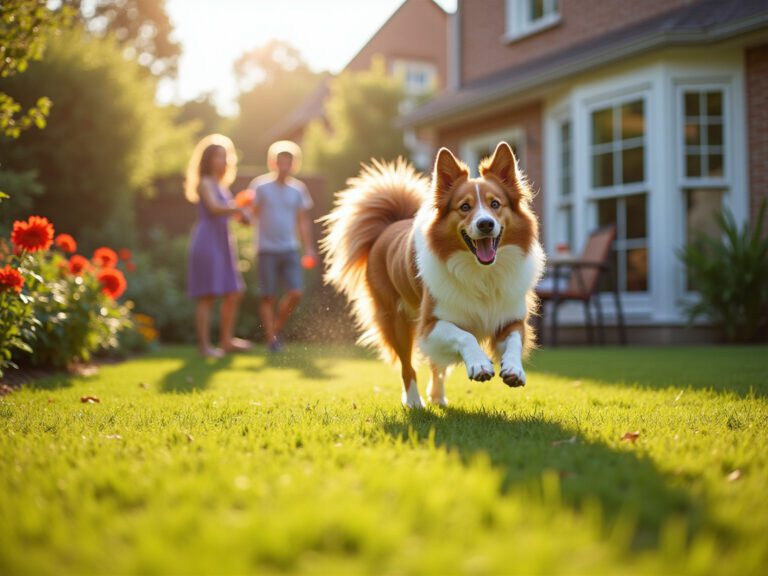Husky Malamute Comparison: Traits, Care, and Family Suitability
Overview
This article thoughtfully compares the traits, care requirements, and family suitability of Siberian Huskies and Alaskan Malamutes, highlighting their unique physical characteristics and temperaments that make them special. Understanding your furry family members is crucial, and it’s important to recognize that Huskies are generally more sociable and adaptable to various living environments. In contrast, Malamutes thrive in spaces that allow for more room to roam and require structured training to ensure they flourish.
As potential pet owners, it’s essential to consider these differences when selecting a breed that aligns with your lifestyle. By choosing the right companion, you can create a nurturing environment that supports both your needs and those of your new pet. Remember, the right choice can lead to a harmonious relationship filled with joy and companionship.
Introduction
Choosing the right dog breed for your furry family members can feel overwhelming, particularly when weighing the merits of two beloved breeds: the Siberian Husky and the Alaskan Malamute. Both breeds, known for their striking looks and rich histories, possess unique traits that cater to various types of dog owners.
As you consider their physical characteristics, temperamental differences, and care requirements, it’s crucial to understand what distinguishes these breeds. This article explores the essential differences between Huskies and Malamutes, offering insights to help you determine which breed aligns best with your lifestyle and needs.
We’re here to support you in making an informed decision that ensures a nurturing environment for your new companion.
Compare Physical Characteristics: Huskies vs. Malamutes
The husky malamute, comprising both the Siberian Husky and Alaskan Malamute, are beloved members of the spitz family that exhibit distinct physical characteristics, making them unique companions. Huskies are typically leaner and more agile, standing between 20 to 23.5 inches tall and weighing 35 to 60 pounds. Their medium-width muzzles and high-set ears contribute to their nimble appearance, making them well-suited for speed and endurance. In contrast, Malamutes are larger and more robust, generally measuring 22 to 26 inches in height and weighing between 75 to 100 pounds. With a broader chest and a stockier build, they are optimized for strength and heavy pulling tasks. Furthermore, the coat of a husky malamute is often softer and less dense than that of a Malamute, whose coarser, thicker fur is designed to withstand extreme cold.
These physical differences not only influence their appearance but also dictate their exercise requirements and adaptability to various living conditions. According to sled dog trainer Susan H. Butcher, the historical context of sled dog racing highlights the abilities of these breeds, emphasizing their endurance and strength. Acknowledging the energy and mental stimulation needs of these wonderful dogs is essential for owners to provide suitable activities. This helps avoid behavioral problems and ensures joyful, healthy companions.
Moreover, prospective owners should recognize the limited number of registered foundational dogs, which raises concerns about the breeds’ susceptibility to the founder effect, impacting their long-term health and genetic diversity. Understanding these traits is crucial for potential owners of a husky malamute to ensure they can meet the needs of this breed, fostering a nurturing environment for their furry family members.
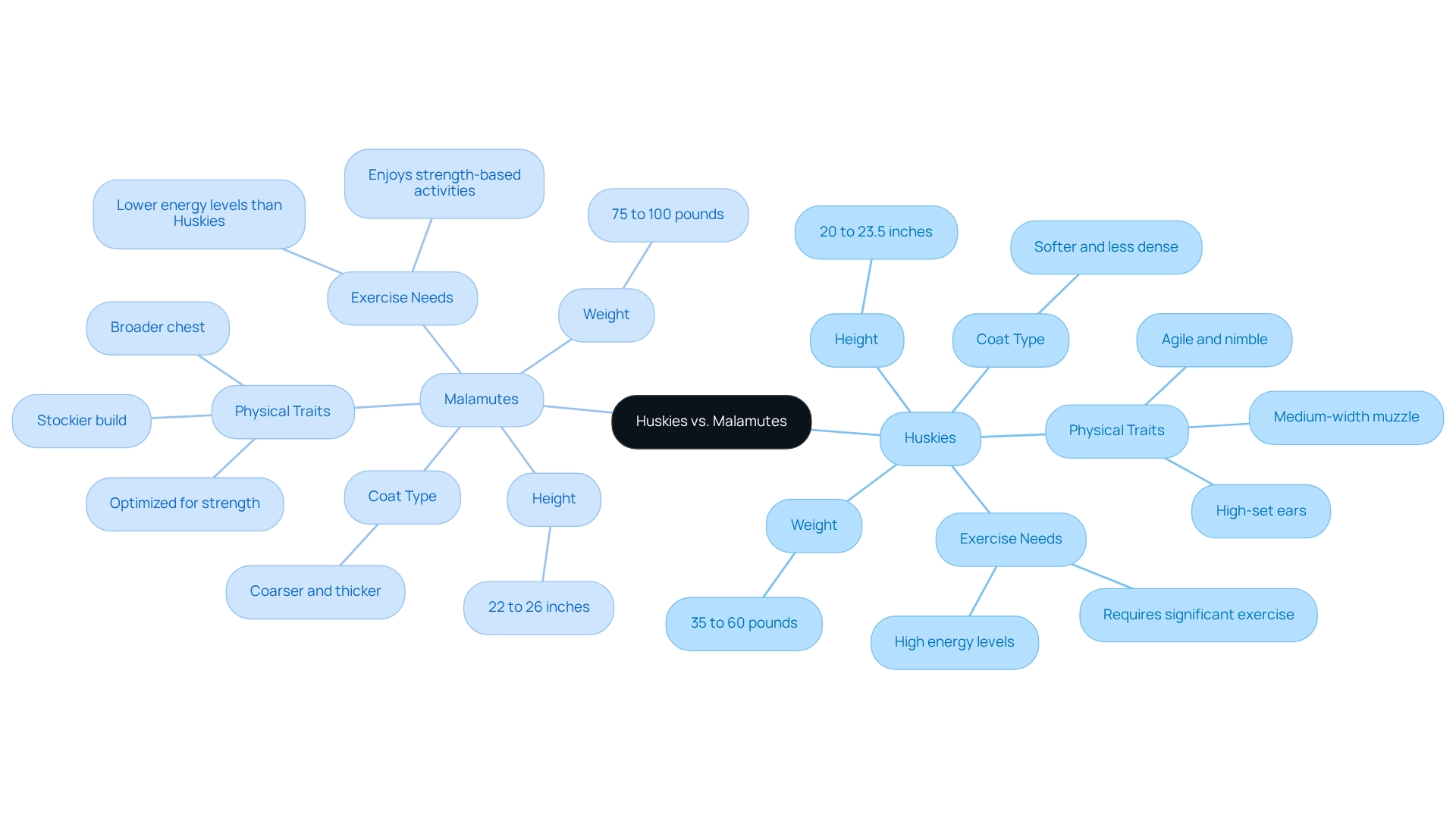
Contrast Temperament and Personality Traits
When evaluating temperament, husky malamutes are cherished for their outgoing and friendly disposition. These highly social dogs thrive on interaction with both humans and other animals, making them ideal companions for active households. However, their playful nature can sometimes lead to mischievous behavior if not properly trained. In contrast, husky malamutes exhibit a more independent spirit, often displaying a dignified aloofness, particularly towards strangers. While they are loving with their family members, these dogs require regular training to manage their strong-willed behaviors.
Notably, rare instances of Alaskan Malamutes can surpass 140 pounds, an important consideration for families regarding space and care requirements. Both breeds are typically amiable, yet the sociability of the husky malamute sharply contrasts with the aloof demeanor of the Malamute, which can significantly influence their suitability for different households. According to specialists, socialization is essential for both types; trainers emphasize that Huskies, due to their playful personality, benefit from early and continuous social interactions, while Malamutes thrive under a firm owner who can provide the necessary structure and guidance.
Gena Box Young, the current judges education chair for the Alaskan Malamute Club of America, advises puppy buyers who already have a dog to consider getting a Malamute of the opposite sex. This distinction is crucial for households contemplating which type aligns best with their lifestyle and environment. Furthermore, families living in warmer areas should be mindful of safety advice for hot-weather animals, ensuring their furry family members remain comfortable and healthy during warm days.
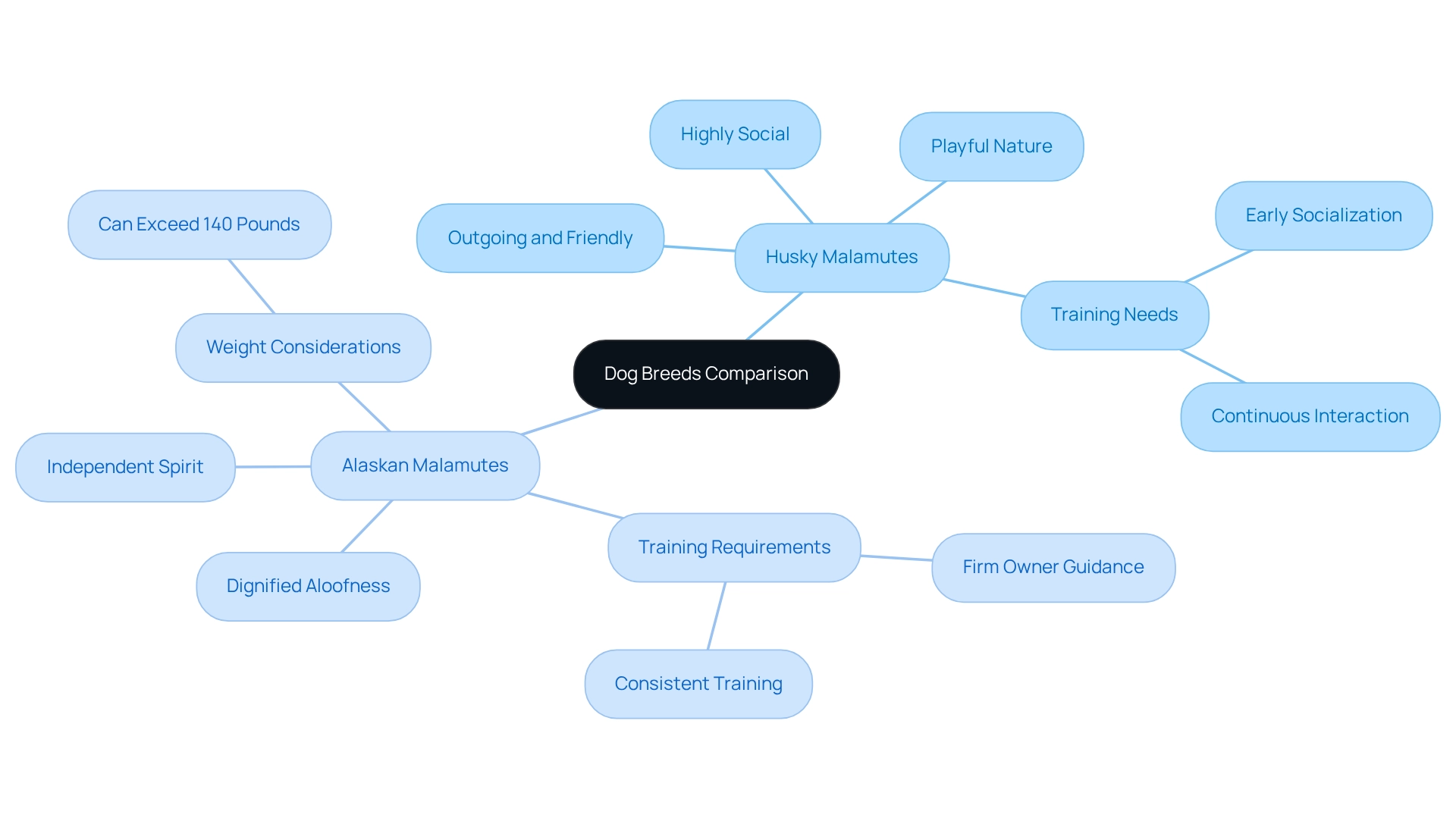
Evaluate Care Requirements: Exercise, Grooming, and Health
Both Alaskan Huskies and husky malamutes are high-energy breeds that require significant exercise to maintain their physical and mental health. Husky malamutes typically require 1.5 to 2 hours of vigorous activity each day, which can include running, playing, and participating in dog sports. In contrast, husky malamute dogs, while also active, generally need about 1 to 2 hours of strength-focused exercise, such as hiking or pulling sleds, to satisfy their robust nature. It’s crucial to recognize that dogs susceptible to orthopedic conditions should steer clear of excessive physical activity to lessen joint stress, while consistent exercise remains vital to avert obesity, customized for each individual.
Grooming requirements differ considerably between the two breeds. Huskies possess a softer coat that necessitates regular brushing to manage their year-round shedding, which intensifies during seasonal changes. Alaskan sled dogs, on the other hand, have a denser coat that requires more frequent grooming to prevent matting and maintain coat health. They are recognized for shedding throughout the year and experiencing a fur storm biannually, making regular grooming essential.
Health factors are also vital for both types. Huskies are prone to genetic conditions such as hip dysplasia and eye problems, while the husky malamute also shares a susceptibility to hip dysplasia and certain heart conditions. Understanding these care requirements is essential for potential owners, ensuring they can create a nurturing environment that fulfills the specific needs of their chosen breed.
At Adventure Den, we prioritize the safety and well-being of all pets. We require up-to-date vaccinations and conduct thorough check-ins to ensure each pet is happy and healthy. As Marta, the owner of Keno, shares, ‘Keno is an older girl with the mindset of a young puppy. Once she knows you, she will never leave you alone and always demand cuddles.’ This affectionate nature highlights the importance of a nurturing environment, such as that provided by Adventure Den, which is committed to personalized care and safety for these breeds.
Assess Suitability for Families and Living Environments
When considering the right pet for your household, the husky malamute often emerges as a favorite for active families due to their playful and sociable nature. They typically engage positively with children and other pets, making them an excellent choice for homes with multiple animals. With 65% of 18- to 34-year-olds planning to adopt a new pet in the next five years, understanding breed suitability is crucial for those contemplating a new addition to their family. However, it’s essential to note that the husky malamute requires ample space and regular exercise to keep them happy and healthy. In contrast, while husky malamutes are also affectionate companions, their larger size and tendency for rough play may render them less suitable for families with very young children. They tend to be more independent and require supervision around smaller pets, so it’s important to consider these factors when choosing the right breed.
Both breeds thrive in environments that offer outdoor space, yet Huskies show a remarkable adaptability to urban living, provided they receive consistent exercise. As Nicole Cosgrove points out, ‘2.8 million dogs accompany their owners to work,’ highlighting how well Huskies can fit into active households. Malamutes, however, flourish in homes with plenty of room to accommodate their strength and size. Ultimately, the decision between a husky malamute and other breeds should reflect your household’s activity level, available living space, and commitment to ongoing training and socialization. Understanding these elements is vital for nurturing a harmonious bond between your furry family members and your home.
Moreover, the dynamics of pet ownership reveal a trend where real-life interactions with animals take precedence over virtual representations. Many owners show a low inclination to create social media profiles for their companions, emphasizing the importance of integrating pets into family life. This makes the choice of breed even more significant, as each pet deserves a nurturing environment where they can thrive.
Conclusion
Choosing between a Siberian Husky and an Alaskan Malamute is a significant decision that requires thoughtful consideration of each breed’s unique traits. Huskies, with their leaner build and friendly disposition, are perfect for active families in search of a playful companion. Their energetic nature and adaptability to various living conditions make them ideal for those who can provide plenty of exercise and social interaction. On the other hand, Malamutes are larger, more robust dogs that flourish in spacious environments and enjoy strength-focused activities. Their independent spirit and dignified presence may resonate with owners who prefer a more reserved companion.
Understanding the physical differences, temperament, and care requirements of these breeds is essential for prospective dog owners. Both breeds need significant exercise and grooming, but their individual needs vary, impacting how they fit into different lifestyles. Moreover, considering each breed’s suitability for families and living environments is crucial to ensuring a positive experience for both the dog and the owner.
Ultimately, the choice between a Husky and a Malamute should be guided by a clear understanding of how each breed aligns with your personal preferences and family dynamics. By reflecting on these factors, you can make an informed decision, ensuring a loving and nurturing home for your new furry family member. Remember, the right choice not only enriches your life but also creates a joyful environment for your pet.
Frequently Asked Questions
What are the main physical differences between Siberian Huskies and Alaskan Malamutes?
Siberian Huskies are typically leaner and more agile, standing between 20 to 23.5 inches tall and weighing 35 to 60 pounds. They have medium-width muzzles and high-set ears. In contrast, Alaskan Malamutes are larger and more robust, measuring 22 to 26 inches in height and weighing between 75 to 100 pounds, with a broader chest and stockier build.
How do the coats of Huskies and Malamutes differ?
The coat of a Siberian Husky is often softer and less dense than that of an Alaskan Malamute, whose fur is coarser and thicker, designed to withstand extreme cold.
What are the exercise requirements for Huskies and Malamutes?
Both breeds require significant exercise and mental stimulation due to their energy levels. It is important for owners to provide suitable activities to avoid behavioral problems and ensure they remain joyful and healthy companions.
What historical context is important for understanding these breeds?
The historical context of sled dog racing highlights the endurance and strength of both breeds, as they were bred for specific tasks related to sled pulling.
What concerns exist regarding the genetic diversity of Huskies and Malamutes?
There is a limited number of registered foundational dogs for these breeds, raising concerns about their susceptibility to the founder effect, which can impact their long-term health and genetic diversity.
Why is it important for prospective owners to understand the traits of Huskies and Malamutes?
Understanding the physical characteristics, exercise needs, and genetic concerns of these breeds is crucial for prospective owners to ensure they can meet the needs of a husky malamute and foster a nurturing environment for their pets.

